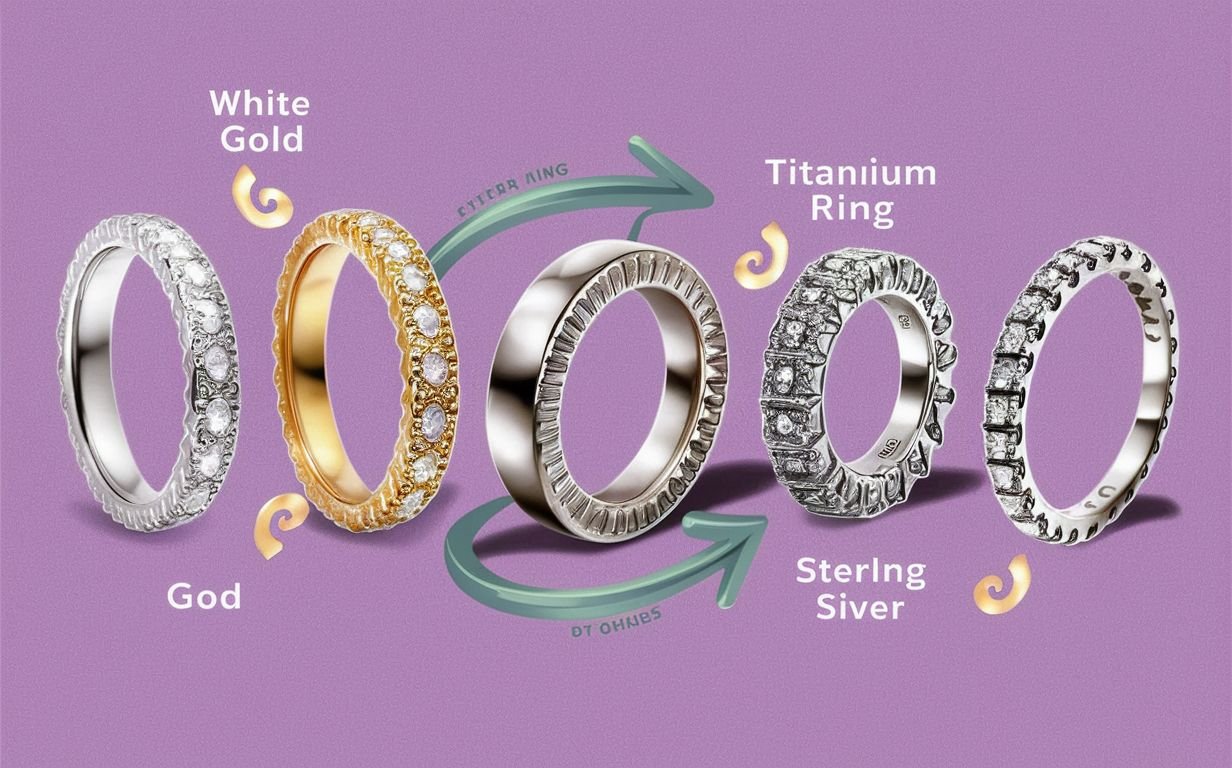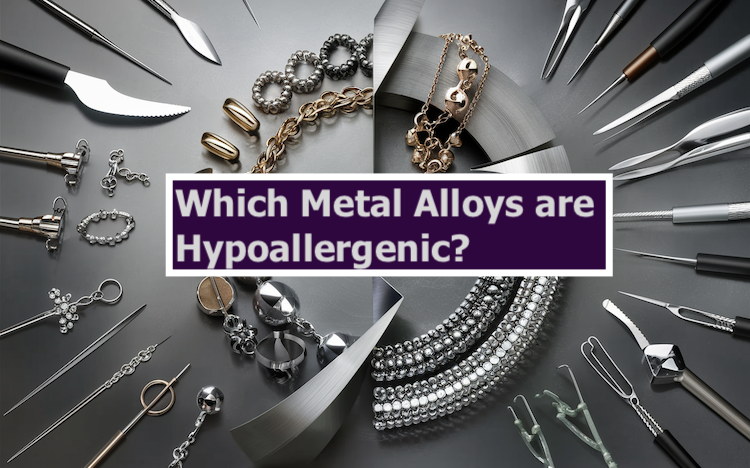White gold, with its elegant luster and versatility, has become a sought-after choice for jewelry enthusiasts. Its shimmering surface complements casual and formal attire, making it a staple in many collections. But beneath its pristine appearance lies a question that echoes through jewelry stores and online forums among individuals with sensitive skin: Is white gold hypoallergenic? Unfortunately, the answer isn’t as simple as a yes or no; however, this article delves into the composition of white gold, its hypoallergenic properties, and practical advice for those seeking to wear it without risking any allergic reactions.
Understanding White Gold
White gold is not a naturally occurring metal; it’s a captivating blend crafted by human hands.

Pure gold, while hypoallergenic, is too soft for everyday jewelry. To enhance its strength and durability, white gold is usually blended with other metals making it an alloy. The key player in this blend is nickel, often used to create the desired white hue. Unfortunately, nickel is a common allergen, and even a small amount can trigger reactions like redness, itching, and blistering in sensitive individuals.
Thankfully, besides nickel, white gold can be blended with other white metals such as palladium, silver, and sometimes zinc, to achieve its distinctive color and enhance its strength. The proportion of these metals varies, influencing the alloy’s color, durability, and hypoallergenic properties.
- 10K White Gold: At 10 karats, they contains 41.7% pure gold and a higher proportion of other metals. Nickel, often present in these alloys, can trigger allergic reactions in sensitive individuals. So, while it’s not the ideal choice for those prone to nickel allergies, it remains popular due to its affordability and durability.
- 14K White Gold: With less nickel than its 10K counterpart, 14K strikes a better balance. It’s still not entirely hypoallergenic, but it’s a step in the right direction. The higher gold content (58.3%) makes it more resistant to deformation and tarnish.
- 18K White Gold: This variation elevates the game. With 75% pure gold, 18K white gold boasts a luxurious feel. It balances metals like palladium, nickel, and zinc. While nickel remains a key player, the higher gold content makes it less prone to causing skin reactions.
The Role of Nickel in White Gold
Nickel, known for its hardening properties, is commonly used in white gold alloys but is also a frequent cause of allergic contact dermatitis (American Academy of Dermatology Association, n.d.). The presence of nickel in can be a significant concern for those with nickel sensitivities.
Nickel’s role in causing allergic contact dermatitis is well-documented, with reactions ranging from mild irritation to severe skin conditions. According to the American Academy of Dermatology, nickel allergies affect approximately 18% of people in North America, making it a significant concern for jewelry wearers.

Is White Gold Hypoallergenic?
The short answer is: it depends. White gold’s hypoallergenic nature is influenced by its composition, particularly the presence and quantity of nickel.
- Nickel Allergies: For individuals allergic to nickel, white gold with lower gold karat containing nickel can trigger allergic reactions, manifesting as skin irritation, redness, and itching where the jewelry contacts the skin. So it’s recommended to choose jewelry with a higher karat value, for example, an 18k white gold.
- Rhodium Plating: Rhodium plating is a common practice to enhance the appearance of white gold and its hypoallergenic properties. This process involves covering the alloy with a layer of rhodium, a metal in the platinum family known for its durability and hypoallergenic nature. Many white gold pieces are plated with rhodium. This hypoallergenic metal enhances the white luster and provides a protective barrier between the skin and the base alloy. However, this plating can wear off over time, potentially exposing the wearer to the underlying nickel-containing alloy. While effective, the plating does wear away over time, especially on frequently worn items like rings and bracelets. This is why some individuals only start experiencing allergic reactions after an extended period of wearing what was initially “hypoallergenic jewelry.” The good news is that reapplication of the coating will maintain both the jewelry’s luster and its skin-friendly barrier.
- Rhodium Plating Thickness: When selecting rhodium-plated white gold jewelry, the thickness of the rhodium layer and the quality of the plating process can impact its longevity and protective efficacy. Discussing these details with jewelers and understanding the maintenance required to preserve the plating’s integrity are crucial steps in ensuring ongoing hypoallergenic protection.
Advancements in metallurgy have led to the development of white gold alloys that eschew nickel, opting instead for metals like palladium, which are less likely to provoke allergic reactions. Inquiring about the specific alloys used in white gold jewelry and opting for these nickel-free alternatives can be a prudent choice for those with sensitivities.
Regular Jewelry Care
Beyond the initial selection, the care and maintenance of the jewelry play pivotal roles in preventing allergic reactions. Regular cleaning to remove accumulated substances that might irritate the skin, proper storage to avoid scratches and damage to the rhodium plating, and timely re-plating before the protective layer wears thin are all practices that can extend the life of the jewelry and safeguard the wearer’s skin.
For those with sensitivities looking to enjoy this jewelry, consider the following tips:
- Seek Nickel-Free Alloys: Some jewelers offer white gold alloys formulated without nickel, using metals like palladium, which are more suitable for sensitive skin.
- Verify Rhodium Plating: Ensure that the jewelry is rhodium-plated and inquire about the thickness of the plating, as a thicker layer offers longer protection.
- Regular Re-plating: Be prepared to have your jewelry re-plated with rhodium periodically to maintain its hypoallergenic barrier and aesthetic appeal.
Conclusion – Is White Gold Hypoallergenic?
While white gold’s elegance is undeniable, its hypoallergenic status is contingent upon its composition and treatment. The question of whether it is hypoallergenic doesn’t have a one-size-fits-all answer, but with informed choices and proactive care, individuals with metal sensitivities can enjoy white gold jewelry without undue concern.
Individuals with metal allergies, particularly to nickel, should exercise caution when selecting white gold jewelry. To minimize the risk of allergic reactions, opt for nickel-free alloys and ensure adequate rhodium plating. By making informed choices and understanding the care requirements of white gold, lovers of this precious metal can enjoy its beauty with confidence, ensuring both style and skin comfort.
FAQS
The hypoallergenic nature of white gold varies with its karat rating due to the different proportions of gold to other metals in the alloy. Here’s a breakdown:
IS 10k White Gold hypoallergenic?:
- Contains a higher percentage of alloyed metals, including nickel, to increase its strength. It’s less likely to be hypoallergenic and may cause reactions in individuals sensitive to nickel.
Is 14k White Gold hypoallergenic?:
- It also contains alloyed metals such as nickel, but in a lesser proportion compared to 10k. Although the risk is moderately reduced, it may still pose a risk for those with nickel allergies.
Is 18k White Gold Hypoallergenic?
- Has a higher gold content and generally contains fewer alloyed metals, making it a safer option for sensitive skin. However, the presence of nickel in the alloy can still cause allergic reactions in some people.
It’s important to note that most white gold is rhodium-plated, which provides a hypoallergenic layer on the surface. Over time, as the plating wears off, exposure to the base alloy can potentially lead to skin irritation.
Is White Gold OK for Sensitive Ears?
White gold can be suitable for sensitive ears, especially if it’s rhodium-plated, as the rhodium provides a hypoallergenic barrier. However, the potential for an allergic reaction increases if the rhodium plating wears off, exposing the skin to the base metal alloys that may contain nickel. For individuals with known sensitivities or nickel allergies, higher karat white gold or other hypoallergenic metals like platinum or titanium are recommended for earrings.
References
American Academy of Dermatology Association. (n.d.). Nickel Allergy: How to Avoid Exposure and Reduce Symptoms. Retrieved from https://www.aad.org/public/diseases/a-z/nickel-allergy
Jewelers of America. (n.d.). Rhodium Plating in Jewelry. Retrieved from https://www.jewelers.org/education/jewelry-metals/rhodium-plating







